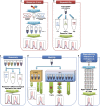Targeted proteomic assays for quantitation of proteins identified by proteogenomic analysis of ovarian cancer
- PMID: 28722704
- PMCID: PMC5516542
- DOI: 10.1038/sdata.2017.91
Targeted proteomic assays for quantitation of proteins identified by proteogenomic analysis of ovarian cancer
Abstract
Mass spectrometry (MS) based targeted proteomic methods such as selected reaction monitoring (SRM) are emerging as a promising tool for verification of candidate proteins in biological and biomedical applications. The Clinical Proteomic Tumor Analysis Consortium (CPTAC) of the National Cancer Institute has investigated the standardization and analytical validation of the SRM assays and demonstrated robust analytical performance on different instruments across different laboratories. An Assay Portal has also been established by CPTAC to provide the research community a resource consisting of large sets of targeted MS-based assays, and a depository to share assays publicly. Herein, we report the development of 98 SRM assays that have been thoroughly characterized according to the CPTAC Assay Characterization Guidance Document; 37 of these passed all five experimental tests. The assays cover 70 proteins previously identified at the protein level in ovarian tumors. The experiments, methods and results for characterizing these SRM assays for their MS response, repeatability, selectivity, stability, and endogenous detection are described in detail. Data are available via PeptideAtlas, Panorama and the CPTAC Assay Portal.
Conflict of interest statement
The authors declare no competing financial interests.
Figures


Dataset use reported in
References
Data Citations
-
- Song E. 2017. PeptideAtlas. PASS00947
-
- Song E. 2017. Figshare. https://doi.org/10.6084/m9.figshare.5106829.v6 - DOI
-
- Song E. 2017. Figshare. https://doi.org/10.6084/m9.figshare.5106580.v5 - DOI
-
- Song E. 2017. Figshare. https://doi.org/10.6084/m9.figshare.5106838.v4 - DOI
Publication types
MeSH terms
Associated data
Grants and funding
LinkOut - more resources
Full Text Sources
Other Literature Sources
Medical
Miscellaneous

